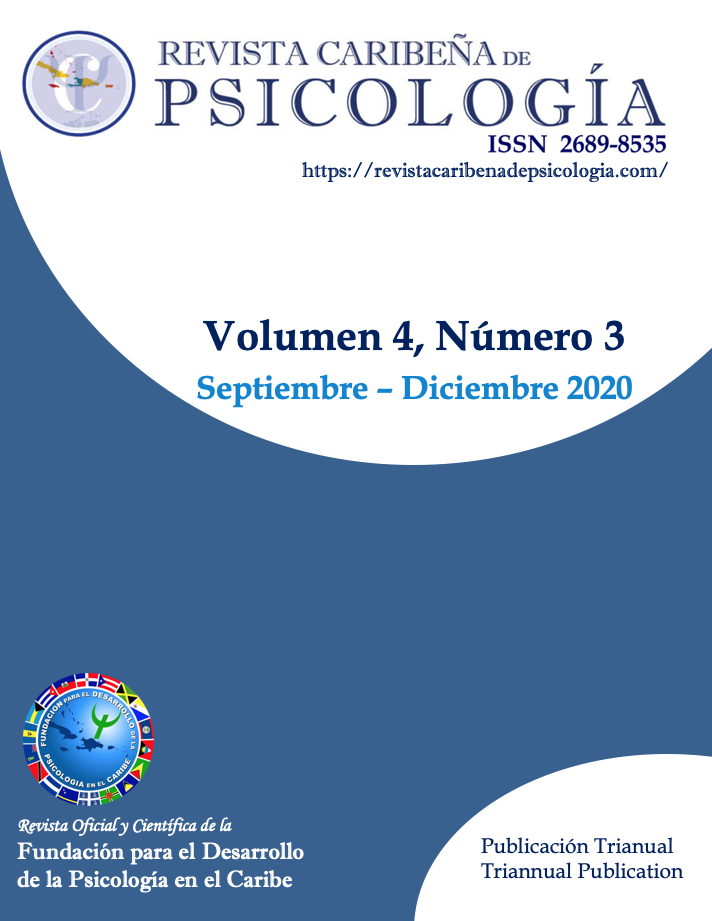Experiencias de Violación Sexual Conyugal en Mujeres Adultas Puertorriqueñas: Un Estudio Fenomenológico
DOI:
https://doi.org/10.37226/rcp.v4i3.4845Palabras clave:
pareja, terrorismo patriarcal, violación sexual conyugal, violenciaResumen
La violación sexual conyugal (VSC) constituye una de las manifestaciones de violencia doméstica más nocivas a la salud física y emocional de las mujeres. Esta investigación exploró el significado de la experiencia de violación sexual conyugal que han sufrido mujeres adultas puertorriqueñas en pasadas relaciones de pareja. La investigación fue una cualitativa con un enfoque fenomenológico. Las participantes fueron ocho mujeres puertorriqueñas, reclutadas por disponibilidad, que sobrevivieron experiencias de VSC. Se utilizó una entrevista semi-estructurada para recopilar la información. Los datos narrativos fueron analizados utilizando el método de Wolcott (1994). Del análisis cualitativo emergieron tres categorías. Se concluye que la violación sexual conyugal es un fenómeno insertado dentro de relaciones complejas de violencia doméstica, que suscita secuelas y significación asociadas al ciclo de la violencia doméstica y al trauma. Se concluye, además, que aún se requieren procesos educativos respecto al género que socaven las ideas de subordinación de la mujer como posible basamento ideológico para su victimización sexual.
Citas
Adams-Clark, A.A. & Chrisler, J.C. (2018). What constitutes rape? The Effect of marital status and type of sexual act on percep-tions of rape scenarios. Violence Against Women, 24(16), 1867-1886. https://doi.org/10.1177%2F1077801218755975
Antai, D. (2011). Controlling behavior, power relations within intimate relationships and intimate partner physical and sex-ual violence against women in Nigeria. MC Public Health, 11(2), 1-11. https://doi.org/10.1186/1471-2458-11-511
Bagwell-Gray, M, Messin, J. T. & Baldwing-White, A. (2015). In-timate partner sexual violence: A review of terms, definitions and prevalence. Trauma, Violence & Abuse, 16(1), 1-20. https://doi.org/10.1177%2F1524838014557290
Basile, K.C., Smith, S.G., Liu, Y., Kresnow, M.J., Fasula, A.M., Gilbert, L. & Ghen, J. (2018). Rape-related pregnancy and as-sociation with reproductive coercion in the U.S. American Journal of Preventive Medicine, 55(6), 770-776. https://dx.doi.org/10.1016%2Fj.amepre.2018.07.028
Breiding, M. J., Smith, S. G., Basile, K.C., Walters, M. L., Chen, J. y Merrick, M. T. (2014). Prevalence and characteristics of sexu-al violence, stalking, and intimate partner violence victimiza-tion: National intimate partner and sexual violence survey in United States, 2011. Morbidity and mortality weekly report. Sur-veillance summaries (Washington, D.C. : 2002), 63(8), 1–18. http://www.ncbi.nlm.nih.gov/pmc/articles/pmc4692457/
Buss, D. M., Larsen, R. J., Western, D. & Semmelroth, J. (1992). Sex differences in jealousy: Evolution, pshysiology and psycholo-gy. Psychological Science, 3(4), 25-255. https://doi.org/10.1111%2Fj.1467-9280.1992.tb00038.x
CAAV (Centro de Ayuda a Víctimas de Violación) (2015). Perfil estadístico del Centro de Ayuda a Víctimas de Violación. Departa-mento de Salud.
Tedeshi, R. G. & Moore, B.A. (2016). The posttraumatic growth workbook: Coming through trauma wiser, stronger, and more resili-ent. New Harbinger Publications.
Campbell, R., Dworkin, E. & Cabral, G. (2009). An ecological mod-el of the impact of sexual assault on women’s mental health. Trauma, Violence, Abuse, 10(3), 225-246. https://doi.org/10.1177/1524838009334456
Catalano, S., Smith, E., Snyder, H. & Rand, M. (2009). Female vic-tims of violence. http://bjs.ojp.usdoj.gov/content/pub/pdf/fvv.pdf
Cresswell, J. W. (2003). Research design: Qualitative, quantitative and mixed methods approaches (2nd Edition). Sage Publications.
Finkelhord, D. & Yllo, K. (1982). Forced sex in marriage: A prelimi-nary research report. Crime and Delinquency, 28, 459-478. https://doi.org/10.1177%2F001112878202800306
Friedman, S. H., Loue, S., Heaphy, E. L. G. & Méndez, N. (2009). Intimate partner violence victimization and perpetration by Puerto Rican women with severe mental illness. Community Mental Health Journal, 47(2), 156-163. https://doi.org/10.1007/s10597-009-9270-z
Johnson, M. P. (1995). Patriarchal terrorism and common couple violence: two forms of violence against women. Journal of Marriage and the Family, 57, 283-294. https://doi.org/10.2307/353683
Johnson, M. P., Leone, J. M. & Xu, Y. (2014). Intimate terrorism and situational couple violence in general surveys: Ex-spouses required. Violence against Women, 20(2) 186–207. https://doi.org/10.1177/1077801214521324
Knudson, D. (1987). “Que nadie se entere: La esposa maltratada en Puerto Rico. En Y. Azise Vargas (Ed.), La mujer en Puerto Rico: Ensayos de Investigación. (p. 139-153). Ediciones Huracán.
Lazar, R. (2010). Negotiating sex: The legal construct of consent in cases of wife rape in Ontario, Canada. Canadian Journal of Women & the Law, 22(2), 329-363. https://www.muse.jhu.edu/article/409073
Ley #54 para la prevención e intervención con la Violencia Doméstica. (1989). Gobierno de Puerto Rico. http://www2.pr.gov/agencias/mujer/Pages/default.aspx
Love, H.A., Spencer, C.M., May, S.A., Mendez, M. & Smith, S.M. (2018). Perpetrator risk markers for intimate terrorism and sit-uational couple violence: A meta-analysis. Trauma, Violence & Abuse. https://doi.org/10.1177%2F1524838018801331
Lucca Irrisarry, N. y Berríos Rivera, R. (2009). Investigación cualitativa: Fundamentos, diseños y estrategias (2da. Edición). Ediciones SM.
Mahoney, P. (1999). High rape chronicity and low rates of help-seeking among wife rape survivors in a nonclinical sample: Implications for research and practice. Violence Against Wom-en, 5(9), 993-1018. https://doi.org/10.1177%2F10778019922181590
Mahoney, P. & Williams, L.M. (1998). Sexual assault in marriage: Prevalence, consequences and treatment of wife rape. En J.L. Jasin-ski & L.M. Williams (Eds.), Partner violence: A comprehensive re-view of 20 years of research. Sage.
Martin, E. K., Taft, C. T. & Resick, P. A. (2007). A review of mari-tal rape. Aggression and Violent Behavior, 12, 329-347. https://doi.org/10.1016/j.avb.2006.10.003
Martín Sánchez, M., RFey Martín, A. y Serrano, A.L. (2018). Estudio integral de la violencia de género. Prámide.
Mengo, C., Okumu, M., Ombayo, B., Shamsun, N. & Small, E. (2019). Marital rape and HIV Risk in Uganda: The impact of women's empowerment factors. Violence Against Women, 25(15), 1783-1805. https://doi.org/10.1177/1077801218821444
Muehlemhard, C. L. & Kimes, L.A. (1999). The social construction of violence: The case of sexual and domestic violence. Person-ality and Social Psychology Review, 3, 234-245. https://doi.org/10.1207%2Fs15327957pspr0303_6
National Violence Against Women Prevention Research Center (2016). General information. http://www.musc.edu/vawprevention/
Osborn, K., Davis, J. P., Button, S., & Foster, J. (2018). Juror Deci-sion Making in Acquaintance and Marital Rape: The Influ-ence of Clothing, Alcohol, and Preexisting Stereotypical Atti-tudes. Journal of interpersonal violence, 886260518768566. Ad-vance online publication. https://doi.org/10.1177/0886260518768566
Padmanabhanunni, A. & Edwards, D. (2016). Rape survivors’ experiences of the Silent Protest: Implications for promoting healing and resilience. Qualitative Health Research, 26(6), 818–829. https://doi.org/10.1177/1049732315573201
Rodríguez-Díaz, G.F., Auger-Cabrera, C., Quintero-Jiménez, N. (2018). Factores internos de resiliencia en una muestra de mujeres residentes de Puerto Rico que han sido víctimas de experiencias de trauma. En R.F. García Robles & S.K. Sayers Montalvo, Resiliencia: Medición de la experiencia interna. Publicaciones Puertorriqueñas.
Russell, D. E. (1982). Rape in marriage. Macmillan Publishing com-pany.
Simonson, K. & Subich, L. M. (1999). Rape perceptions as a func-tion of gender-role traditionally and victim perpetrator asso-ciation. Sex Roles, 40, 617-634. https://doi.org/10.1023/A:1018844231555
Snipes, D.J., Calton, J.M., Green, B.A., Perrin, PB & Bonotsc, E.J. (2017). Rape and Posttraumatic Stress Disorder (PTSD): Ex-amining the mediating role of explicit sex-Power beliefs for men Versus women. Journal of Interpersonal Violence, 32(16), 2453-2470. https://doi.org/10.1177/0886260515592618
Walker, L. E. (1979). The battered woman. Harper & Row.
Walker, L. E. (1984). The battered woman syndrome. Springer Pub-lishing Company.
Walker, L. E. (2009). The battered woman syndrome (2nd edition). Springer.
Wolcott, H. F. (1994). Transforming qualitative data: Description, analysis, and interpretation (3rd Edition). Sage.
Yebisi, O. & Balogun, V. (2017). Marital rape: A tale of two legal systems. Obiter, 38(3), 540-55.
Yllo, K. & Torres, G. (2016). Marital rape: Consent, marriage and social change in global context. Oxford Press.
Publicado
Cómo citar
Número
Sección
Licencia
Derechos de autor 2020 Jose Osvaldo Reyes

Esta obra está bajo una licencia internacional Creative Commons Atribución 4.0.







